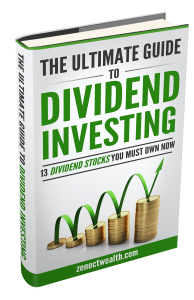Is This Warren Buffett’s Way Of Finding Perfect Dividend Stocks?
I love talking about stocks with other investors. Often times you’ll see two people argue passionately over the price of a stock. One guy thinks the stock is priced too low… The other two high.
What they’re arguing is whether a stock is overvalued, undervalued, or perfectly valued!
It’s what makes the the market a market!

So, the million dollar question is how do you value a stock?
I’m going to give you a few different ways – then give you a Crazy way I’d look at value (and Buffett might use it too!).
So, let’s discuss value.
If you talk to an Economics Professor he might pull out the famous DCF Valuation. It’s called a Discounted Cash Flow Valuation.
How To Uses DCFs To Value Dividend Stocks
It’s complicated.
What you do is estimate the amount of cash flow the business will throw off… for a long time period – sometimes as many as 10 years. Then you apply a discount rate, factor in the net present value… Bla Bla Bla Bla Bla…
Look – truth is, this is only a valuation metric used by idiots in ivory towers. It’s got no value in the real world.
Never once – in my 20 plus years of trading – have I ever done a DCF analysis to see if a stock is undervalued or not.
It’s just not used.
If you talk to a mutual fund manager about stock values, they might talk to you about P/E ratios or PEG ratios.
The P/E Ratio is one of the most widely used ratios.
Here’s How You Use P/E Ratios With Dividend Stocks
With the P/E ratio you’re simply comparing the price of the stock divided by the Earnings Per Share (EPS)…
So a $50 stock with a $5 yearly EPS has a P/E ratio of 10x $50/$5=10x
And a $17 stock with a $1.70 yearly EPS also has a P/E Ratio of 10x
This gives you an easy way to compare stocks of different prices with different EPS numbers to see which is under or overvalued.
***************************
Get our free report: “Ultimate Guide To Dividend Investing”
The report includes 13 Dividend Stocks to Buy Today!
Download Your Dividend Guide HERE
Get Your Free Copy Today!
***************************
One important thing to remember is the average P/E ratio for the S&P 500 is around 15x… and for each industry, the number is slightly different.
Just remember 15x as your above / below target to give you a good idea of reality. If you see a P/E ratio of 400x (I did in the dot com boom) you know to dig in deeper and see what’s going on.
The same applies if you see a P/E ratio of 2x or 3x… there’s something strange going on at those businesses – dig deeper!
Another ratio mentioned by fund managers is PEG Ratios:
Here’s How To Use PEG Ratios With Dividend Stocks.
The peg ratio is simply a way of looking at the value of a company and factoring in the company growth rate.
For example… you might have two companies trading at a Price / Earnings ratio (P/E ratio) of 15x. But that doesn’t mean they are valued the same… if one company shows EPS growing at 10% and the other is growing at 40% the PEG ratio shows the difference.
For example:
15x P/E / 10% Growth = 15/10= 1.5 PEG
15x P/E / 40% Growth = 15/40= 0.37 PEG
Like in golf, the lower the number the better, the 40% grower is undervalued here despite having the same P/E Ratio.
Now those are just a few ways to look at value… there are a hundred others out there. And while some are useful, others are useless.
Let Me Share A Slightly Crazy Way To Look At Value.
Ready? Instead of comparing company to company… compare the value of a company over time.
You see, if you’ve got your eye on a great company… how do you know if the value you’re buying is great… or if you’re tossing hard earned money after bad?
You look at the long term average dividend yield.
Put it this way… a stock price goes up and down… and a dividend payment hopefully goes up (but sometimes down). The dividend yield changes day to day…. But over a really long time you’ll see if the stock is undervalued or overvalued… and you’ll quickly see where investors have pegged the valuation of the company based on the dividend yield!
Now a warning…
This analysis only works on companies that have great long term businesses and a management team that believes in the dividend. That’s why I like to use it on dividend stocks.
If you try to look at a business that’s on a roller coaster… and the financials are all over the place, using this analysis will just set you up for destruction.
So let’s dig into a handful of dividend payers.
ALPS International Sector Div Dogs ETF (IDOG)
Suburban Propane Partners, L.P. (SPH)
Kinder Morgan, Inc. (KMI)
Deere & Company (DE)
Phillips 66 (PSX)
Cedar Fair, L.P. (FUN)
These stocks all have great businesses… and have paid dividends for years. They all have their pros and cons…
Which one would you look at buying?
Here’s what I’d buy…
The company I picked started paying dividends in 2012… and back then the Yield was pegged at under 2% with the low yield being 1.65%.
To find out which one I added to the dividend portfolio, download my free report “The Ultimate Guide to Dividend Investing.”
Not only will you get my report on a great dividend stock… but I’ll give you some basics around the rules to dividend investing… plus a cool dozen other dividend stocks you should consider for your portfolio.
I’ll rush the report to you right away… just sign up today!
